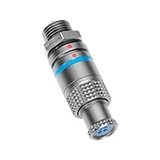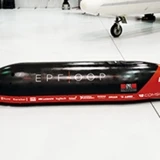Hyperloop, a quantum leap in transportation

First conceived over a hundred years ago, the idea of a magnetic levitation train launched in a vacuum tube is now becoming a reality.
Elon Musk gave it new impetus in 2013, he christened it Hyperloop . Since then, it has inspired thousands of people to get on board. Get ready to travel at 1,200km per hour by land.
It was around 2012 when Elon Musk almost choked upon learning about a traditional high-speed train project that California was looking to develop for 60 billion dollars. Too slow, too expensive, unworthy of a State that hosts the Silicon Valley. Elon Musk’s teams set to work on a new project, borrowed and assembled already existing ideas and technologies and published a 60-page white paper in August 2013. This was Hyperloop Alpha, a system of pods on an air cushion (to avoid the friction generated from contact with the ground) transporting around twenty passengers, “flying” at 1,200km per hour in vacuum tubes (to avoid air resistance). This project would link Los Angeles and San Francisco (a little more than 600km apart) within only thirty minutes and it would cost 6 billion dollars.
Once he presented the idea, Musk announced that he would not have the time for it. He was going to focus on his other projects, namely Tesla and SpaceX. He filed no patent applications for the concept and called for “open source” development.
Innovation, like nature, abhors a vacuum, so others went for it. Start-ups were created to launch projects to take Elon Musk’s incomplete proposal further.
Hyperloop One is one of the major players. Launched in 2014, they developed the technology and applied for dozens of patents. Richard Branson joined the Board of Directors in 2017 after forming an investment partnership with the company, which was then renamed as Virgin Hyperloop One. General Electric, the SNCF (French national railway company) and Dubai Ports World are also among the investors. Hyperloop projects have been planned in several countries around the world, namely in Dubai, the USA and England. In February 2018, India joined the race by signing an agreement for a demonstration line between Pune and Mumbai.
Hyperloop Transportation Technologies (HyperloopTT) is another big player. Based in Los Angeles, the company, founded in 2013, relies on an international collaborative network of hundreds of specialists. They have reportedly filed 27 patents, built R&D centres and launched several feasibility studies. They have projects in the USA, in France, in the Czech Republic and in several Asian countries, including China. Like Virgin Hyperloop One, they have already developed their test tube and pod.
Among the competitors, there are also Transpod in Canada, DGWHyperloop in India and Arrivo in the USA. For them, just like for all the others, the aim is to gather knowledge, along with millions of dollars of investments to fund the maximum number of experimental projects which pushed the boundaries. Hyperloop represents a quantum leap in transportation and a huge commercial opportunity should it become the technology of the future. Companies around the globe are already jostling for position to ensure they are ready to fully capitalise on this potentially multi-billion dollar race.
Land development concepts would need to be completely rethought
Hyperloop sparks the imagination as its speed alone has the potential to shrink the world.
A Hyperloop pod could be almost three times quicker than even the fastest of trains currently running (the Shanghai Maglev with its maximum speed of 431km per hour). As geographers and urbanists have observed, such speed would not really be useful for gaining time on shorter journeys (such as reduced commuting time), but mostly for travelling further afield. Hyperloop would place New York as little as 30 minutes from Washington. It would be perfectly possible to livein one city, to go to work 500km away and to be back home by supper time. Land development concepts would need to be completely rethought.
According to Elon Musk and others, the costs of building and operating Hyperloop would be lower than those of a modern railway network. This is a lot harder to calculate.
Passive magnetic levitation, as envisaged by Virgin Hyperloop One, would certainly save costs compared to classic maglevs. In fact, they require huge amounts of electricity to supply electromagnets set up along their route. With passive magnetic levitation, there are magnets permanently on the vehicle. As the trains move over conductive arrays, they generate the magnetic field that “carries” the pods – there is no need for electricity. Levitation, in addition to a vacuum created in the tubes, drastically reduces friction. The linear electric motor drives the train that “glides” with a minimum of loss. Energy would even be recovered during braking.
However, the biggest questions about the costs are related to infrastructure. Tunnels will have to be drilled or aerial structures built. Tubes have to be built and assembled. The tubes will also need to be vacuumed (which requires a lot of energy), airlocks need to be multiplied so that passengers can enter and exit without depressurising the tubes. Flawless maintenance must be provided over thousands of kilometres: tubes need to prove to be vacuum tight and tracks must be kept in perfect condition, so that wear does not jeopardize the system’s efficiency, or safety.
Travelling onboard a Hyperloop pod is like climbing into a window-less rocket launched in a steel tube, like a bullet in a gun barrel. How comfortable would that be? What would happen if, at the speed of 1,200km per hour, the tube would be damaged or depressurised? If terrorists would blow up a section? How many G’s would passengers experience in the event of an emergency braking? How would they come out of their pod and the tube to get back into the open air? There is plenty of cause for concern. The promoters of Hyperloop insist that it seems to be perfectly normal to travel in a steel tube launched at high speed – aka airplanes.
As for all major infrastructures, the main constraints will neither be technology nor people’s concerns. They will come from politics and administration. It is quite common for “simple” road, rail or air infrastructures to be subject to endless opposition or delays. Therefore, the development of an as yet non-existent means of transport, using new technology, with as yet unproven safety and maintenance costs may very well take years or even decades of standstill before obtaining all the authorisations, finetuning and complying with all the regulations.
For all these reasons, many people consider the Hyperloop system utopian and unfeasible. However, such doubts will not stop entrepreneurs like Richard Branson or Elon Musk. By the way, the latter has not stayed away from the Hyperloop project for too long. At the end of 2016, he announced the launch of The Boring Company, an infrastructure and tunnel construction company, which was selected, in particular by the city of Chicago to build a high-speed rail connection to its O’Hare International Airport. Not an actual Hyperloop (no vacuum tubes), but enough to position itself on the market.
In parallel, Musk has also launched, via SpaceX, the Hyperloop Pod Competition, a student competition to design and build Hyperloop pods. The first round took place in January 2017. A Dutch team from Delft University won the first prize in engineering. The speed competition, using the mile-long vacuum tube built on the grounds of SpaceX in Hawthorne, California, was won by a German team from the University of Munich.
The second round took place in August 2017. Over 1,200 projects were submitted to SpaceX, who invited the 27 best on site. This time, the focus was on speed and the University of Munich won again with their prototype racing at 323km per hour.
The third round was held last July with even more interest: out of thousands of applications, 20 teams were invited to California with their prototypes.
For both SpaceX and the students, it’s a win-win deal. Musk’s company has an attentive technology monitoring service and can use the data collected during the week of the competition. The students hugely benefit from a great training programme, they are judged by the best rocket engineers and can test their prototype on an infrastructure of which there are only a few examples worldwide. The competition has given rise to several start-ups founded by teams that had participated. For example, Delft University launched Hardt Global Mobility and is working on a Hyperloop tube project in Europe. The Spanish Universitat Politècnica de València is another example, who launched Zeleros dedicated to sustainable transport.
Whether too far-fetched or not, Elon Musk managed to boost technological advances to an amazing extent. Thanks to the passion and know-how of thousands of scientists, engineers and entrepreneurs who embarked on this “Hyperloop Movement”, we will soon be able to travel like Jules Verne had imagined.


